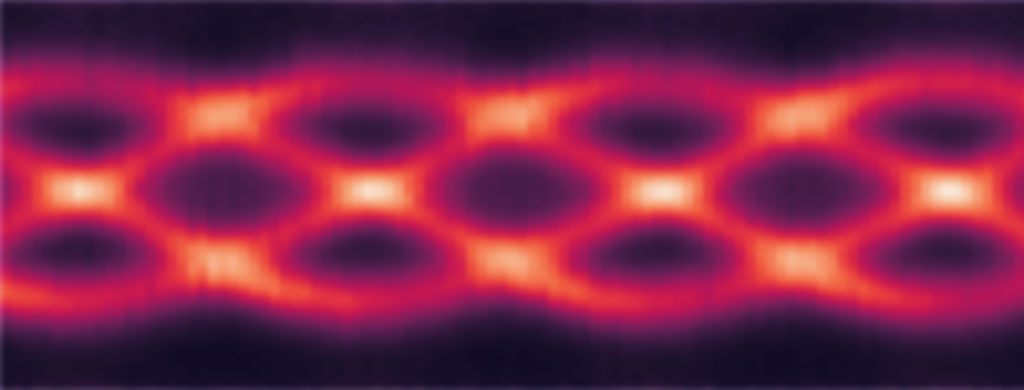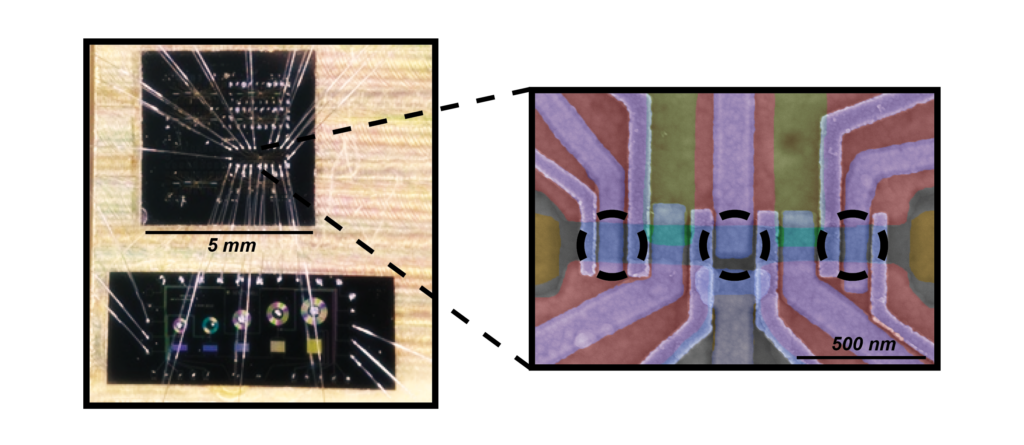30.04.2025Qubit Research
Majoranas on the move

Researchers at QuTech in Delft have combined superconductors and quantum dots to observe and manipulate so-called Majorana bound states, which have properties that could enable stable quantum computation. By building a chain of three coupled quantum dots in a two-dimensional electron gas, they were able to demonstrate properties of Majoranas that are essential for the study of Majorana-based quantum bits. The results were published in Nature this week.
Majorana bound states in one-dimensional systems
One of the key issues in quantum computing remains the inherent instability of quantum bits. In the quest for fault-tolerant quantum computers, topological quantum bits are expected to be significantly less prone to errors. Key to these qubits are quasiparticles called Majorana bound states, which have been predicted to appear on opposite edges of one-dimensional superconducting systems.
Senior author Srijit Goswami: “For years, this search for Majorana bound states has focused on extended one-dimensional semiconductor-superconductor hybrid devices. However, these systems turned out to suffer from disorder, which makes it very difficult to reliably engineer Majorana bound states and to study them in detail. You’re essentially at the mercy of the material quality.”

Left: The 2DEG chip measured in these experiments (top) connected to a chip containing electrical resonators (bottom), that enable fast calibrations. Right: Electron microscope image of a nanoscale device used to study Majoranas. Voltages applied to the thin electrodes (or gates) are used to create quantum dots at the positions indicated by dashed circles. Small strips made of superconducting Aluminum allow for turning the chain of three quantum dots into a so-called Kitaev chain.
Kitaev chains with three artificial atoms
To create a highly controlled model system, the Delft team returned to the basic Kitaev model that predicted Majoranas in 2000. They created a system ‘block-by-block’ in a chain of artificial atoms, called quantum dots (QDs). This technique allowed them to engineer Majorana bound states in a systematic and deterministic way.
In the past years through a strong combined effort of theorists and experimental teams working on different material platforms, research at QuTech has significantly advanced the understanding of these Kitaev chains. Starting with the study of two-site chains in nanowires and two-dimensional electron gases (2DEGs), it has now become possible to extend these chains, and understand how the properties of the Majoranas evolve. Complementing a recent work on three-site chains in nanowires, this work shows how 2DEGs can be used to systematically create, manipulate and probe Majoranas.
First author Bas ten Haaf: “By carefully tuning the way the quantum dots interact, we clearly observed that Majoranas emerge simultaneously on the left and on the right side of the system, and not in the middle.”
The stability of topological qubits relies on the presence of a ‘bulk-gap’, physically separating the two Majorana bound states and keeping them from ‘annihilating’ each other. In the model system of the Delft team, the middle quantum dot acts as a tunable bulk-gap, that can selectively be present or removed. “When we remove this gap, the Majorana bound states on the outer quantum dots are no longer stable, exactly as Kitaev predicted,” says ten Haaf. “The Kitaev model is very simplified. It’s a toy model. I was surprised to see how well our observations agreed with it.”
While signatures of Majorana bound states have been reported before, this is the first work to use a minimal model system to probe simultaneously what happens on the left, middle, and right side.
Moving Majoranas around
The authors also exploited their control over the system to show that the location of Majoranas could be moved from one QD to another. This ability to move Majoranas is important for topological quantum computing. In this long sought-after technology, the positions of the Majoranas are swapped to create intricate braiding patterns that encode information in a way that is robust against random errors.
The Delft team plans to add more quantum dots so that they can actually swap the positions of two Majoranas. “A T-shape made of six quantum dots will allow us to test braiding operations and create a basic qubit,” explains Goswami. “It’s not going to be the best qubit, but will allow studies of the fundamental properties of Majoranas.”
Goswami: “What fascinates me much more than building a quantum computer with our quantum dots, is uncovering how these Majoranas work and what we can do with them. How do they interact? How do they couple? These are the things we are trying to discover.”


